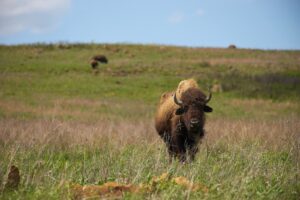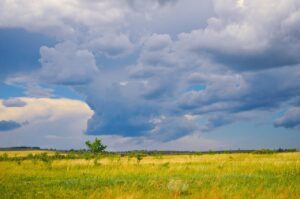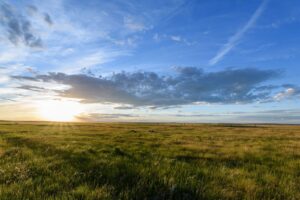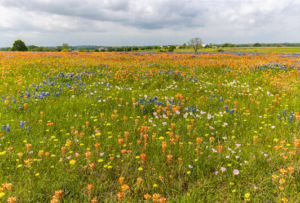Hundreds of years ago, much of the central United States was covered in prairie and grassland. Bison and deer roamed the plains, while smaller mammals and birds benefited from the covering and forage provided by native grasses.
We might be biased, but we believe the native prairie is arguably one of the most perfect ecosystems that has ever existed. However, due to land conversion and degradation, we have lost much of this valuable natural heritage. Restoring native prairies is important both for the ecological benefits and also for honoring and respecting an important region.
Benefits of Native Prairies
The prairie ecosystem is a valuable part of our natural heritage, providing many benefits to both wildlife and humans. Prairie grasses help to reduce soil erosion and filter pollutants from water. The deep root systems of grasses store carbon, creating resilience in the face of climate changes, and serve an important hydrological function of absorbing water, which helps to protect and preserve the aquifer.
Native prairies support diverse plant communities, including many species of wildflowers and forbs that provide food and habitat for a wide range of wildlife, from insects to birds and mammals.
Steps to Restoring Native Prairies

If you have an old field, meadow, circle corner, etc. that you want to revegetate into a successful native habit, you have come to the right place. We have the seed and the insight you need for successful restoration.
Site Preparation
Site preparation is crucial for the success of any restoration project. Before planting, you’ll need to evaluate the existing vegetation and decide what steps are necessary to reduce competition so that planted species can germinate and grow. It’s also important to evaluate the site to determine important features such as drainages, slope, or other physical features important in planning the restoration project.
Seed Selection
Selecting the right seeds for your project is essential. Species and varieties of native grasses and forms that are best adapted to your soils and goals should be selected. A plan should provide for the planting of at least four perennial species adapted to the ecological region and adapted to the site. Annual forb species should not be introduced on the site until planted grass species become established if herbicide strategies are going to be used.
There are two ways our team can help you as you determine the right seed for your project.
The first way is by calling our office. We will connect you with one of our Reclamation Specialists right away. They will make note of your location, needs, and goals, and help you develop a custom blend that restored native grasslands and prairies.
The other way we can help you is through our tool: Seed-Spec.
With Seed-Spec, you simply plot your location points; then the tool will pull up the characteristics of your soil, and use that information to develop a custom blend for your area.
Planting
Preferred planting dates for perennial forb seed are during the fall, particularly the October-November period. Forb seeds may be planted with mechanical seed drills or broadcast spreaders, hand-carried seeders, broadcast by hand, or mixed and incorporated with grass seeds during the grass planting process. Most forb seeds require shallow planting depths into a firm seedbed. Native grass seed should be planted in Texas between January and June at the latest (depending on soil temperatures). Our team always recommends the use of a native seed drill to seed at the correct depth and avoid planting seeds too deeply. 
For an in-depth guide to planting and establishment, view our free in-depth guide:
Key Species to Plant
When selecting grass species to plant, it is important to consider the specific characteristics of the site, including soil type, moisture level, and microhabitat factors. Planting a mix of different grass species can help improve the overall health and resilience of the prairie ecosystem. Some key grass species to consider include:
Site Management
Bringing back a native prairie or grassland is a long game. It takes patience and planning to establish a native prairie or grassland.  During the first year, the growth of native grass and perennial forbs may not appear impressive. Most growth of these plants will be below ground in the development of root systems. Annual broadleaf weeds and weedy grasses will respond to soil disturbances associated with initial planting operations and may compete with the plants you’re trying to establish. Mowing may be necessary during the first two years to reduce competition from annual weeds and undesirable grasses. Grazing is usually not recommended until the stand is well established. That is normally at least a full growing season. Grazing under a rest and rotation system is always recommended. Prescribed burning is also a tool that can be used for site management. No burning should be conducted during the first three years after grasses have been planted.
During the first year, the growth of native grass and perennial forbs may not appear impressive. Most growth of these plants will be below ground in the development of root systems. Annual broadleaf weeds and weedy grasses will respond to soil disturbances associated with initial planting operations and may compete with the plants you’re trying to establish. Mowing may be necessary during the first two years to reduce competition from annual weeds and undesirable grasses. Grazing is usually not recommended until the stand is well established. That is normally at least a full growing season. Grazing under a rest and rotation system is always recommended. Prescribed burning is also a tool that can be used for site management. No burning should be conducted during the first three years after grasses have been planted.
Restoring Native Prairies And Biodiversity
Restoring native grasslands and prairies not only benefits the ecosystem but also contributes to the preservation of biodiversity. Prairies support a wide range of plant and animal species, and restoring these habitats can help to bring back endangered or threatened species. By restoring native grasslands and prairies, we can help to preserve the unique biodiversity of our region for future generations.
Restoring native grasslands and prairies is an important step towards preserving a critical ecosystem that benefits both wildlife and people. By following the key steps of site preparation, seed selection, planting, and site management, you can restore land into a thriving ecosystem that provides essential habitat for native wildlife, improves soil and water quality, and enhances the beauty of your property. With the help of resources like Bamert Seed’s Seedspec.com and local conservation agencies, we can work together to restore and protect these valuable ecosystems for generations to come.



